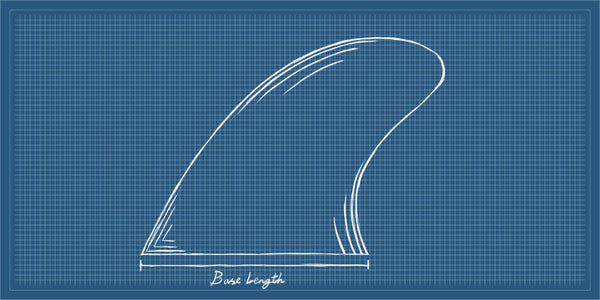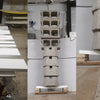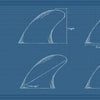Twin Fins Talk: The Ultimate Guide to Choosing Your Perfect Twin (part 3)
In this blog, we will talk about the shape of the fins and how they are described and measure. This will give us a great idea of the shape and able us to compare different fins with similar surface area that would react totally differently.

Height or depth
The height of a fin is the distance from the base to the tip of the fin. The height of a fin affects the hold, release, drive, and pivot of your surfboard. In general, the taller the fin, the more hold you will get, but the less release you will have. Usually, a higher fin will tend to have less rake and will allow for more pivot, we’ll cover this later. For twin-fin surfboards, the height of a fin is especially important, a higher fin will provide more stability while reducing your ability to go rail to rail quickly. If you are a beginner or intermediate surfer, you may need taller fins to provide more stability and forgiveness. If you are surfing in weaker and softer waves, you may need taller fins to generate more speed and lift. If you are an experienced surfer, you’re surfing fast waves, want to go rail to rail fast and release off the top then you might want to go with a fin that is shallower.
Base width

A wide base fin will help you generate drive, drawn-out turn, and will help you track straight with speed, but a wide base will limit your ability to pivot. Again, your weight, your skills, your board, and the wave you are riding will affect your choice regarding the width of the base of your fin. If you want to generate a lot of speed in a large wave that has an open face for a big drawn-out turn, then a wide base will help you while if you want to pivot tight in a pocket you might go with a fin with a smaller base. Keep in mind that the base also influences your surface area so if you are big guys, you would go around with a wider base than smaller guys.
Usually, a board with a parallel outline and a wide tail like a Steve Lis or Skip Frye retro fish will be fun with a wide base (keel fins) that will provide the right amount of surface area, will complement the outline that wants to go fast and straight and will still allow for rail to rail and release due to the low depth of the fin.
On a curvier outline and narrower tail surfboard like the MR California twin or the CI Twin Pin a narrower base and more upright fin will be a right fit for pivot and drive.
Rake


Rake is a tricky aspect of a fin to measure, but it makes a big difference in how a fin performs. Some people measure the rake as the angle between the front and the back of the fin, but I think that it is not very reliable, because different people may measure it differently. I prefer to measure the rake as the horizontal distance from the back of the fin box (in my futures fin box) to the tip of the fin at the back. That way, I can get an clear idea of how much surface area there is on that part of the fin. A high-raked fin will give you more stability and less pivot, while a low-raked fin (upright template) will give you more pivot and less stability. A high-raked fin will allow you to carve longer and smoother turns, while an upright fin will let you Pivot faster and sharper.
Keep in mind that a raked fin with a wide base will also affect where the surface area of your fin is located on your surfboard, so it will feel like the fin box is closer to the tail. If you want more control and hold on your board, you can use a high-raked fin. If you want more maneuverability and playfulness on your board, you can use a more upright fin.
Next
The next blog of this serie will be on more subtile aspects of fins, that are also important in your selection. The Material the Foiling and the Cant.




